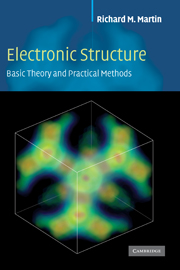Book contents
- Frontmatter
- Contents
- Preface
- Acknowledgments
- Notation
- Part I Overview and background topics
- 1 Introduction
- 2 Overview
- 3 Theoretical background
- 4 Periodic solids and electron bands
- 5 Uniform electron gas and simple metals
- Part II Density functional theory
- Part III Important preliminaries on atoms
- Part IV Determination of electronic structure: the three basic methods
- Part V Predicting properties of matter from electronic structure – recent developments
- Appendix A Functional equations
- Appendix B LSDA and GGA functionals
- Appendix C Adiabatic approximation
- Appendix D Response functions and Green's functions
- Appendix E Dielectric functions and optical properties
- Appendix F Coulomb interactions in extended systems
- Appendix G Stress from electronic structure
- Appendix H Energy and stress densities
- Appendix I Alternative force expressions
- Appendix J Scattering and phase shifts
- Appendix K Useful relations and formulas
- Appendix L Numerical methods
- Appendix M Iterative methods in electronic structure
- Appendix N Code for empirical pseudopotential and tight-binding
- Appendix O Units and conversion factors
- References
- Index
1 - Introduction
from Part I - Overview and background topics
Published online by Cambridge University Press: 05 June 2012
- Frontmatter
- Contents
- Preface
- Acknowledgments
- Notation
- Part I Overview and background topics
- 1 Introduction
- 2 Overview
- 3 Theoretical background
- 4 Periodic solids and electron bands
- 5 Uniform electron gas and simple metals
- Part II Density functional theory
- Part III Important preliminaries on atoms
- Part IV Determination of electronic structure: the three basic methods
- Part V Predicting properties of matter from electronic structure – recent developments
- Appendix A Functional equations
- Appendix B LSDA and GGA functionals
- Appendix C Adiabatic approximation
- Appendix D Response functions and Green's functions
- Appendix E Dielectric functions and optical properties
- Appendix F Coulomb interactions in extended systems
- Appendix G Stress from electronic structure
- Appendix H Energy and stress densities
- Appendix I Alternative force expressions
- Appendix J Scattering and phase shifts
- Appendix K Useful relations and formulas
- Appendix L Numerical methods
- Appendix M Iterative methods in electronic structure
- Appendix N Code for empirical pseudopotential and tight-binding
- Appendix O Units and conversion factors
- References
- Index
Summary
Without physics there is no life
Taxi driver in MinneapolisSummary
Since the discovery of the electron in 1896–1897, the theory of electrons in matter has ranked among the great challenges of theoretical physics. The fundamental basis for understanding materials and phenomena ultimately rests upon understanding electronic structure. This chapter provides a brief outline with original references to early developments of quantum mechanics and the pioneering quantitative theories that foreshadowed most of the methods in use today.
Electrons and nuclei are the fundamental particles that determine the nature of the matter of our everyday world: atoms, molecules, condensed matter, and man-made structures. Not only do electrons form the “quantum glue” that holds together the nuclei in solid, liquid, and molecular states, but also electron excitations determine the vast array of electrical, optical, and magnetic properties of materials. The theory of electrons in matter ranks among the great challenges of theoretical physics: to develop theoretical approaches and computational methods that can accurately treat the interacting system of many electrons and nuclei found in condensed matter and molecules.
Quantum theory and the origins of electronic structure
Although electric phenomena have been known for centuries, the story of electronic structure begins in the 1890s with the discovery of the electron as a particle – a fundamental constituent of matter. Of particular note, Hendrik A. Lorentz modified Maxwell's theory of electromagnetism to interpret the electric and magnetic properties of matter in terms of the motion of charged particles.
- Type
- Chapter
- Information
- Electronic StructureBasic Theory and Practical Methods, pp. 1 - 10Publisher: Cambridge University PressPrint publication year: 2004
- 3
- Cited by



